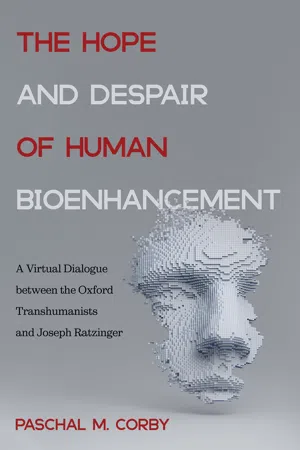![]()
Chapter 8
The Case for Moral Enhancement
Unfit for the Future or Called to Love?
In this chapter, the prospect of moral bioenhancement is presented as a further mutation of human hope, exposing the pessimism and despair that is present in Persson and Savulescu’s support for technological moral enhancement. Rooted in a materialistic reduction of human nature, transhumanists perceive morality to be restricted by evolutionary biases and biological limitations. The human spirit, bound by these shortcomings, finds difficulty in surpassing its inherent moral limitations, even when cognitively aware of them. Thus, moral development lags behind cognitive enhancement, with the danger that technological power is increasingly placed in the hands of morally inept human beings.
In again highlighting the fiction of the positivistic attenuation of the human spirit, Ratzinger offers a more hopeful account of the human potential for morality. He insists that the human capacity for love offers real hope for moral enhancement. Love affirms both the goodness of the other and of creation, moving from the particular toward the universal, and allowing human beings to go beyond spatial and temporal biases and limitations.
In placing love at its foundation, Ratzinger highlights the relational nature of morality. In the absence of such love, he identifies an emerging hatred for humanity, born of despair and a lack of trust in the human potential for goodness. Ultimately, in the affirmation of love, morality exists within the horizon of humanity’s communion with God. Offering a distinctively Christian take on moral development, Ratzinger recognizes human beings’ dependence on divine grace toward enhancement, acknowledging that, in contrast to the secularization of hope through human activity, the human person never acts alone in history.
Unfit for the Future: The Case for Moral Enhancement
Persson and Savulescu’s case for biotechnological moral enhancement rests on the premise that moral development has been unable to keep pace with the rapid changes in human society through advancements in science and technology, such that human beings lack the moral and psychological capacity to adequately respond to the challenges that these advances create. According to their thesis, human morality and psychology evolved within small and close-knit communities, responding to issues affecting their immediate environment. Human morality therefore has a bias toward short-term and close-range issues. However, within the contemporary context, the horizon of moral responsibility has expanded. With scientific and technological advancements, human beings now have the power to affect global changes, but their capacity to reason globally has not advanced alongside it. There is, therefore, an urgent need to bridge the gap between power and responsibility, “to prevent the powerful output of technological progress being misused with catastrophic results.”
Persson and Savulescu identify two areas in which the disparity between technological power and morality has reached crisis point: (1) the threat of weapons of mass destruction, especially if they were to fall into the hands of terrorist groups; and (2) the threat of climate change and environmental degradation. In order to respond properly to these challenges, it is suggested that some radical changes are necessary in the way we live our lives. To combat the threat of terrorism, increased surveillance would mean encroachments on personal privacy. To tackle the problem of environmental change, we need to seriously curb our use of the world’s resources, seek alternative means of energy, implement policies that are more altruistic and with an eye to the future.
The authors propose two possible solutions to the impending threats to human existence: (1) increased surveillance by external authority; and (2) moral enhancement through biotechnology.
Increased Restrictions
Persson and Savulescu acknowledge that security restrictions and reductions in energy consumption will be felt most keenly in affluent, liberal societies which advocate personal rights and opportunities for advancement. In order to effectively respond to the current threats, governments will need to become much more directive, abrogating personal privacies in order to ensure security, and imposing the necessary restrictions on energy consummation that human beings, limited by close-range biases and lacking in altruism, find difficult to make by themselves. They suggest that providing information about what needs to be done is not enough, but in light of our malleability to social norms are hopeful that appropriate coercion can bring about change. However, they co...
